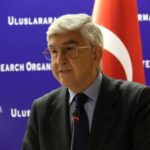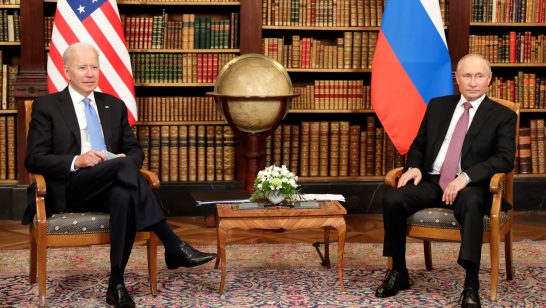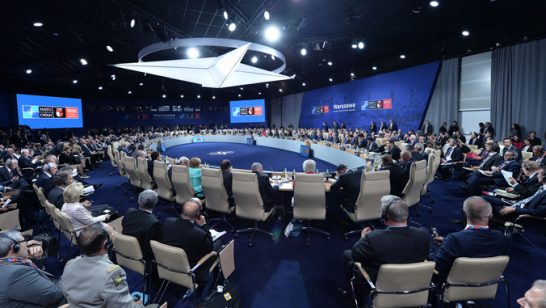
The Ukraine crisis has caused the biggest rift between Russia and the West since the end of the Cold War. The crisis has resulted in thousands of deaths, including the downing of a Malaysian passenger jet over Ukrainian airspace in July 2014 that killed all 298 people on board, and has caused billions of dollars of destruction. The conflict has also reverberated on a regional and global level in the form of an increased risk of military conflict between NATO and Russia, intensified geopolitical and geo-economic divisions, and it has undermined international cooperation against common threats such as ISIS in the Middle East.
Perhaps most importantly, as the Ukraine crisis remains unresolved, the wider military build-up in the Euro-Atlantic area carries an immediate danger of military conflict as a result of a mistake or miscalculation by either side. This situation is not sustainable. Thus, such a danger must be kept to a minimum even if it cannot totally be neutralized. On both sides, many would agree with these words, but the question now is how would this goal be best achieved in the current circumstances?
To provide some solutions, first and foremost we need to look at where we are in the Ukraine crisis. The ceasefire agreement, produced through the efforts of Germany and France on 18 February 2015, is largely holding between Ukraine and pro-Russian rebels. Despite the fact that this agreement is more comprehensive than the first ceasefire agreement signed in September 2014 (although this was never implemented), it is not difficult to find many analysts in Russia, the West and Ukraine who view the current ceasefire as shaky and the renewal of heavy fighting between the parties quite possible.
The latest ceasefire agreement contains a number of measures to de-escalate the crisis and provides the basis for a political solution in the future. However, there is not a single provision in the agreement that Ukrainian and pro-Russian rebels fully agree on, reflecting contradictory positions on the nature of the conflict. Russia continues to express that it is not a combatant in the conflict in Ukraine and so there is no need for Moscow to be bound by any provisions of the agreement. The key asset that Russia wants to keep under its control in order to continue pressuring the Kiev government on political matters and to support pro-Russian rebel groups in Eastern Ukraine is the long border with Ukraine. Most agree that a renewal of heavy fighting would not bring any success to Ukraine’s 250,000 strong military forces in the face of a pro-Russian army of 100,000 rebels supported by Moscow. It is because of the ongoing risk of the renewal of the conflict and an inability to prevent ceasefire violations that western countries extended sanctions against Russia until January 2016.
It is the context of fragile ceasefire in Ukraine and ongoing disagreements between western countries and Russia on the Ukraine crisis that has not only maintained the risk of a renewal of the military clashes in Ukraine but also continues to increase the risk of military collision between NATO and Russian military forces. Such a collision in the Baltic region, Black Sea and some other regions is now not out of the question. The consequences of a military accident involving NATO and Russian military forces will surely be much more serious and dangerous for both sides, and other states, when one thinks of the reality of a confrontation occurring between a nuclear armed alliance and a nuclear armed state.
Since March 2014, it has been reported that there is an increasing pattern of military activities on the part of both Russia and NATO. Indeed, the risk of a military encounter between Russia and NATO during the recent period is well documented by the latest position paper of the Task Force on Cooperation in Greater Europe.
As pointed out in that paper, the European Leadership Network, a London based think-tank and one of the partners of the Task Force on Cooperation in Greater Europe alongside my own International Strategic Research Organisation (USAK) in Ankara, has identified 66 military incidents between NATO and Russian forces, and between the Russian military and those of Sweden and Finland. Of these military encounters, three were classified as carrying a high risk. The Position Paper argues that military exercises have also increased in size and number on both sides. Russia has also deployed additional air and sea defensive and offensive military equipment to Crimea, and increased military activities, for example by using surveillance aircraft and long-range strategic aviation.
Although NATO and Russian military forces as well as national armed forces have so far shown restraint in these military encounters and exercises, this cycle of continuous military activities carries a high risk – a picture reminiscent of the Cold War confrontation between the West and the Soviet Union.
It seems clear that Western countries inside and outside NATO will change their approach towards Russia only if Moscow demonstrates a more constructive position in the Ukraine crisis and Moscow itself is so far showing no signs of changing its own position. The most important factor in the meantime, therefore, is the need to keep the mutual military activities of Russia and NATO under control.
Last year, in its second Position Paper, the Task Force on Cooperation in Greater Europe urged NATO, the EU and Russia to strictly follow three measures to reduce the military risk. It recommended them first to “exercise full military and political restraint”, second to “embrace increased military to military communication, information exchange and transparency measures” and third to “engage in direct dialogue with each other”. These recommendations are just as relevant today. Open communication channels that exist between NATO and Russian General Staff are surely of great value, but are still not enough to eliminate the military risk.
What is also needed now is the urgent re-convening of the NATO-Russia Council not just for consultation or re-opening the communication channels between the two sides, but for producing a memorandum that would better prevent NATO and Russian military forces from making a mistake. Specifically, we need the Council to discuss a possible Memorandum of Understanding between NATO and the Russian Federation on the Rules of Behaviour for the Safety of Air and Maritime Encounters between the two sides. This would build on similar agreements between the United States and Soviet Union during the Cold War period, and a similar agreement that was signed between the United States and China in late 2014.
Although the Ukraine crisis and its wider repercussions do not seem to be abating, there are still things that can be done to avoid the situation worsening. Just such as agreement would be one of them.
The opinions articulated above represent the views of the author(s), and do not necessarily reflect the position of the European Leadership Network or any of its members. The ELN’s aim is to encourage debates that will help develop Europe’s capacity to address the pressing foreign, defence, and security challenges of our time.



